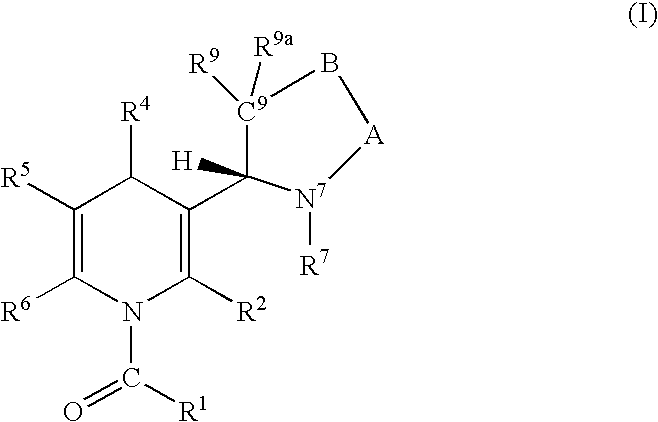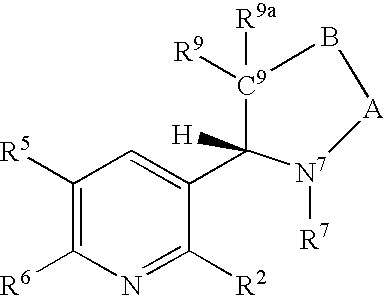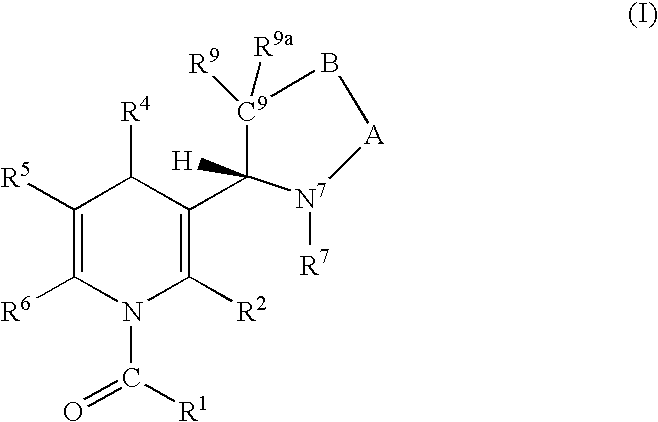Regiospecific synthesis of nicotine derivatives
a nicotine analog and synthesis technology, applied in the field of regiospecific synthesis of nicotine derivatives, can solve the problem that nicotine analogs are difficult to synthesiz
- Summary
- Abstract
- Description
- Claims
- Application Information
AI Technical Summary
Problems solved by technology
Method used
Image
Examples
example 1
Preparation of 1-[4-(Dimethylphenylsilanyl)-3-(1-methylpyrrolidin-2-yl)-4H-pyridin-1-yl]-2,2-dimethylpropan-1-one (I)
[0065]
[0066] First a solution of (dimethylphenylsilyl)magnesium bromide (4 mmol) in THF was prepared according to our previous procedure and cooled to −78° C. A solution of CuBr.SMe2 (0.4 g, 2 mmol) in 4 mL of diisopropyl sulfide was added dropwise to the solution of the Grignard reagent prepared above. The resulting solution was then stirred at −78° C. for 30 min during which time it turned brown-orange. In the meantime, a solution of nicotine (0.16 mL, 1 mmol) in 1 mL of THF was cooled to 0° C. and was treated with pivaloyl chloride (0.12 mL, 1 mmol). The salt was stirred at 0° C. for 1.5 h. It was then cooled to −78° C. and the solution of cuprate prepared above was injected via a double tipped needle surrounded by dry ice. The reaction mixture was then stirred at −78° C. for 4 h and then at −30° C. overnight. After warming to room temperature, the mixture was que...
example 2
Preparation of 4-(Dimethylphenylsilanyl)-3-(1-methylpyrrolidin-2-yl)pyridine (II)
[0069]
[0070] To a solution of I (1 g, 2.6 mmol) in 80 mL of toluene was added sublimed sulfur (0.09 g, 2.6 mmol). The reaction mixture was stirred and heated at 90° C. for 2 days. Evaporation of the solvent under reduced pressure afforded 1.11 g of crude product. Purification by radial PLC (5% EtOAc / hexanes) yielded 0.6 g (76%) of product II as a yellow oil. IR (neat) 2950, 2774, 1579, 1427, 1251 cm−1; 1H NMR (400 MHz, CDCl3) δ 8.72 (s, 1 H), 8.27 (d, 1 H, J=6.8 Hz), 7.31-7.13 (m, 6 H), 3.03 (t, 1 H, J =10.8 Hz), 2.95-2.90 (m, 1 H), 1.97-1.86 (m, 2 H), 1.69 (s, 3 H); 13C NMR (100 MHz, CDCl3) δ 148.6, 146.2, 145.4, 144.3, 137.0, 133.5, 132.6, 128.9, 128.0, 127.5, 127.1, 68.0, 56.0, 39.4, 35.3, 22.1, −1.69, −1.74. HRMS Calcd for C18H24N2Si: 297.1787 [M+H]+. Found: 297.1801 [M+H]+. [α]D25−82.05 (c 4, CH2Cl2).
example 3
Preparation of 3-(1-Methylpyrrolidin-2-yl)pyridin-4-ol (III)
[0071]
[0072] To a solution of II (0.9 g, 3.2 mmol) in 10 mL of methanol was added potassium hydrogen fluoride (0.25 g, 3.2 mmol). A solution of 30% hydrogen peroxide in water (0.88 mL, 7.7 mmol) was slowly added, and the reaction mixture was stirred and heated at 55° C. for 8 h. To the crude mixture was added K2CO3 until the pH of the solution became slightly basic (pH 8-9). After filtration of the solid and evaporation of the solvent, the crude product was purified by radial PLC (EtOAc) to yield 82% of III as a white solid. IR (neat) 2598, 23448, 1643 cm−1; 1H NMR (300 MHz, CDCl3) δ 8.68 (s, 1 H), 8.58-8.56 (m, 1 H), 8.12 (dd, 1 H, J=1.5 and 8 Hz), 7.47 (dd, 1 H, J=5.1 ans 8 Hz), 4.61 (dd, 1 H, J=7.2 and 12 Hz), 3.79-3.59 (m, 2 H), 2.94 (s, 3 H), 2.72-2.1 (m, 4 H); 13C NMR (75 MHz, CD3OD) δ 170.5, 152.8, 151.4, 141.3, 124.9, 78.3, 71.4, 54.1, 29.5, 21.1. HRMS Calcd for C10H14N2O: 179.1184. Found: 179.1190 [M+H]+. [α]D25: ...
PUM
| Property | Measurement | Unit |
|---|---|---|
| temperature | aaaaa | aaaaa |
| temperature | aaaaa | aaaaa |
| temperature | aaaaa | aaaaa |
Abstract
Description
Claims
Application Information
 Login to View More
Login to View More - R&D
- Intellectual Property
- Life Sciences
- Materials
- Tech Scout
- Unparalleled Data Quality
- Higher Quality Content
- 60% Fewer Hallucinations
Browse by: Latest US Patents, China's latest patents, Technical Efficacy Thesaurus, Application Domain, Technology Topic, Popular Technical Reports.
© 2025 PatSnap. All rights reserved.Legal|Privacy policy|Modern Slavery Act Transparency Statement|Sitemap|About US| Contact US: help@patsnap.com



